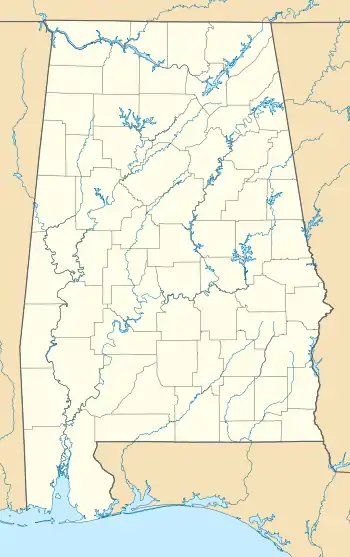Fort Armstrong (Alabama)
Fort Armstrong was a stockade fort built in present-day Cherokee County, Alabama during the Creek War.
| Fort Armstrong | |
|---|---|
 Map of Alabama during the War of 1812. Fort Armstrong is located on the upper right portion.[1] | |
| Location | Cherokee County, Alabama |
| Nearest city | Cedar Bluff |
| Coordinates | 34°12′00″N 85°35′29″W |
| Built | October 1813 |
 Location of Fort Armstrong in Alabama | |
History
Fort Armstrong was built in October 1813 by soldiers under the command of General James White, who was serving under General John Alexander Cocke.[2] The fort was named for John Armstrong Jr., who was the Secretary of War at that time.[3] The fort was built to help protect the local Cherokee from incursions by Red Sticks but also in anticipation of a future assault on the Red Sticks.[2] Boats were assembled at Fort Armstrong to transport supplies further down the Coosa River. Fort Armstrong was in turn supplied by wagons from Fort Ross.[4]
Prior to the Battle of Talladega, General Andrew Jackson ordered General White and his troops to proceed to and guard Fort Strother. General Cocke simultaneously ordered White to return to Fort Armstrong due to the known lack of supplies at Fort Strother. En route to Fort Armstrong, White attacked the Hillabee and destroyed their towns without knowing they had declared peace with Jackson.[3]
Cherokee soldiers who were part of Jackson's forces were stationed at Fort Armstrong. The Cherokee soldiers were allowed to participate in individual raids against the Red Sticks.[5] After the Battle of Talladega and the Hillabee Massacre, many Cherokee continued to be stationed at Fort Armstrong even though they were furloughed by Jackson. In January and February 1814, they were part of the 2nd Regiment East Tennessee Volunteer Militia and helped guard supply and communication lines. Some of the soldiers also guarded Pathkiller and his residence in Turkeytown. The Cherokee who remained at Fort Armstrong built a council house and square ground.[6] Colonel Gideon Morgan oversaw the Cherokee soldiers from Fort Armstrong and was in constant communication with their Indian agent, Return J. Meigs Sr.[7]
On March 2, 1814, Colonel Morgan gave orders to his adjutant, John Ross, to rendezvous at Fort Armstrong with the remaining Cherokee forces and march to Fort Strother. Colonel John Williams and the 39th Infantry Regiment simultaneously transferred supplies from Fort Armstrong to Fort Williams to aide Jackson's forces in anticipation of the Battle of Horseshoe Bend.[8]
John Ross and his brother Andrew operated a store at the site of Fort Armstrong after the Creek War.[9]
After Fort Armstrong no longer had a military use, a ferry operated at the site.[10]
The original fort site is unknown. The Jacksonville State University Archaeological Resource Laboratory has performed archaeological investigations on Pruett's Island, which is thought to be the approximate location of Fort Armstrong. It is possible the site was inundated by the formation of Weiss Lake.[10]
The 1st and 2nd Regiment of East Tennessee Militia, the 1st and 2nd Regiment Tennessee Volunteer Infantry, the 1st Regiment Volunteer Mounted Infantry, and a detachment of the 8th Brigade of Tennessee Militia were all stationed at Fort Armstrong at some point.[11]
Location
Thomas M. Owen reported Fort Armstrong was located on the Etowah River, while Albert J. Pickett stated it was built on Coosahatchie Creek.[12] Most evidence points to it being located on the north bank of the Coosa River near Turkeytown and present-day Cedar Bluff.[13][10]
References
- Lossing, Benson (1868). The Pictorial Field-Book of the War of 1812. Harper & Brothers, Publishers. p. 778.
- Braund, Kathryn E. Holland (2012). Tohopeka: Rethinking the Creek War & the War of 1812. Tuscaloosa, Alabama: University of Alabama Press. p. 123. ISBN 978-0-8173-5711-5.
- War With The Creek Indians. Harper's Magazine Company. 1864. p. 608.
- Braund 2012, p. 123.
- Braund 2012, p. 126.
- Braund 2012, p. 129.
- Morgan, Gideon. "[Letter] 1814 Feb. 4, Fort Armstrong, [Alabama to] Colo[nel] R[eturn] J. Meigs, Highwassee [i.e., Hiwassee] Garrison". Digital Library of Georgia. University of Tennessee, Knoxville. Retrieved 8 September 2020.
- Braund 2012, p. 132.
- Gary E. Moulton (1 October 1978). John Ross, Cherokee Chief. University of Georgia Press. p. 9. ISBN 978-0-8203-2367-1.
- Marshall, Lamar; Smith, Larry; Wren, Michael. "Alabama Collection Camps, Forts, Emigrating Depots and Travel Routes Used During the Cherokee Removal of 1838-1839" (PDF). National Park Service. Retrieved 1 September 2020.
- Kanon, Tom. "Regimental Histories of Tennessee Units During the War of 1812". Tennessee State Library and Archives. State of Tennessee. Retrieved 7 September 2020.
- Pickett, Albert James (1878). History of Alabama, and Incidentally of Georgia and Mississippi, from the Earliest Period. Tuscaloosa, AL: Willo Publishing Company. p. 579.
- Harris, W. Stuart (1977). Dead Towns of Alabama. Tuscaloosa, Alabama: University of Alabama Press. p. 36. ISBN 0-8173-1125-4.